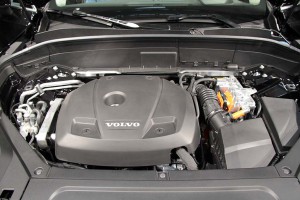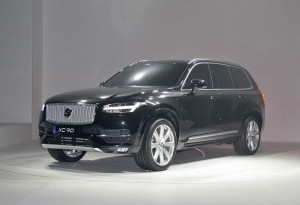The all-new XC90 SUV that made its debut this week marks the beginning of a major shift in powertrain strategy by Volvo Cars, the Swedish automaker abandoning V-6 and V-8 power in favor of more advanced 4-cylinder gas, diesel and hybrid technology.
But Volvo is set to reach even further, company officials reveal, in its bid to balance performance and fuel economy. It also is developing a new line of 3-cylinder engines, and will soon add not just one but two different plug-in hybrid powertrains to its line-up.
“A few years ago, I would have said this was a risky strategy,” admitted Lex Kerssemakers, the maker’s global product strategy chief, but he added he is “confident” about the approach as buyers around the world migrate to smaller, more fuel-efficient engines even in big SUVs and crossovers like the 2016 Volvo XC90.
The new model will offer a mix of two new Drive-E gasoline engines, and two diesels, all four-cylinder. About a year after its market introduction next April, Volvo will add a plug-in hybrid version of the XC90 that will also be its top performing model, at a combined output of 400 horsepower.
(Click Here for a close-up look at the all-new Volvo XC90.)
The maker has been promoting its “all four-cylnder” strategy for several years. But in 2013, it quietly began working on a 3-cylinder engine, as well. It is, essentially, a version of the inline-four Drive-E powertrain with one cylinder removed, noted Michael Fleiss, the maker’s powertrain chief, and will have a displacement of 1.5 liters.
That oversimplifies the development process, Fleiss quickly added during an interview with TheDetroitBureau.com. He noted that because of their design, 3-cylinder engines need to be counterbalanced to soften out harsh vibrations that would otherwise be unacceptable to consumers.
All versions of the new 3-cylinder engine will be turbocharged, Fleiss said, adding that the fundamentals of the powertrain’s design actually means they respond to turbos better than bigger four-cylinder engines.
“A 3-cylinder is the perfect engine for turbocharging,” he stressed.
The 3-cylinder engines will be slightly cheaper than the current Volvo Drive-E 4-cylinder powertrain. But an equal benefit is the smaller size. That would allow Volvo to pair it with an electric motor to create a hybrid or plug-in that could fit into one of the new small cars the maker is planning to introduce late in the decade.
(Volvo “likely” to begin importing cars from China to the U.S. in 2015, says CEO. Click Here for the full story.)
As part of its transformation, the Swedish company is developing 11 new models. Some, like the 2016 Volvo XC90, will be based off the new SPA “architecture,” while others will use the flexible compact CMA platform that is being jointly developed by Volvo and its Chinese parent Geely.
Dubbed the T8, the plug-in hybrid engine Volvo plans to bring out in the XC90 next year will be expensive but powerful, and serve as the brand’s flagship engine. It will not only deliver 400 horsepower but also more than 450 pound-feet of torque.
But in an interview, Senior Vice President of R&D Peter Mertens revealed Volvo is “also working on a lower-performance, simpler” plug-in hybrid powertrain that could have broader mass appeal than the costly T8 package, especially as it would yield even better fuel economy.
Mertens said Volvo is upbeat about the potential of hybrids, both conventional and plug-in, especially in the U.S. market, though other Volvo officials cautioned that powertrains like the Volvo T8 will likely need government help, in the form of tax and other incentives, to gain significant traction. Volvo CEO Hakan Samuelsson noted that sales in the Netherland surged dramatically for an earlier plug-in Volvo developed after the country offered incentives to buyers.
Volvo is also studying its options when it comes to pure battery-electric vehicles, or BEVs, noted product strategist Kerssemakers. But he cautioned that the maker will add the technology only if it sees the potential for “sustainable” demand. For the time being, it will limit its powertrain mix to small turbocharged gas and diesel engines, hybrids and plug-ins.
(Jaguar and Land Rover will work with parent Tata Motors on new Indian SUV family. Click Here for more.)



The engine down sizing programs are a phase the auto makers are being forced to endure to try and meet the absurd 54.5 mpg CAFE requirement. After consumers experience high engine wear from over worked small engines, auto makers will return back to more practical sized engines as a necessity.